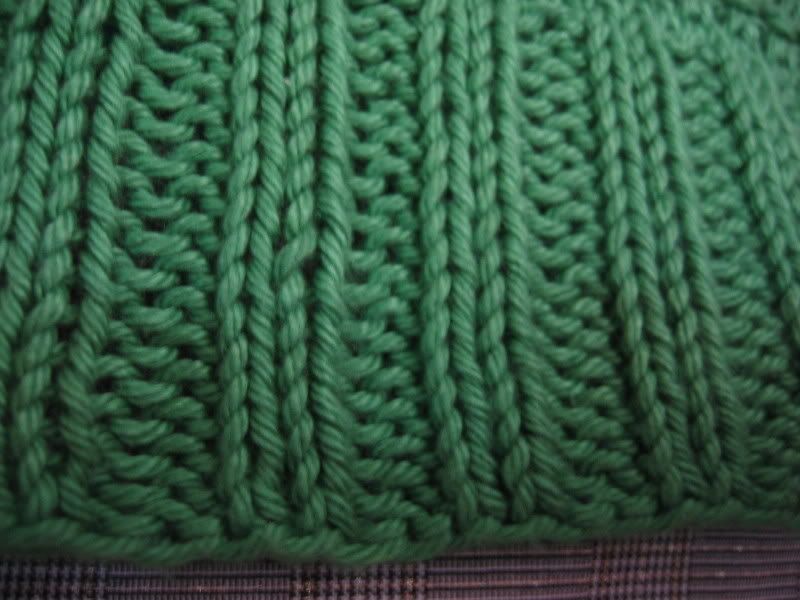I got stuck when this question came up: Can a cyclic group have repeating elements, such as (1, 2, 2, 1) or equivalently, (1, 1, 2, 2)?
See, in the set theory model of knitting I'm working on, there are only two elements: knit and purl. Obviously, those repeat a lot in knitting patterns. So the pattern/cycle of stitches in a given position in the row is going to have repetitions.
I emailed my professor, and he said he'll "have to give it some thought." Crazy!
Also, I have to clean up some mistakes from last night.
Consider the 2x3 rib pattern over 20 stitches.
Knitting notation:
Row 1: K2, P3, repeat to end of row.
Row 2: K3, P2, repeat to end of row.
In set theory terms, I notated the domain (Row 1) and range (Row 2) as follows:
Row 1: KKPPPKKPPPKKPPPKKPPP
Row 2: PPKKKPPKKKPPKKKPPKKK
MAJOR IMPORTANT NOTE: Row 1 is written left to right; Row 2 is written right to left.
That's because in knitting, you turn the work at the end of each row. Alternating rows having you facing the "right side" (outside) or "wrong side" (inside) of the garment. That's just the mechanical nature of knitting.
So your progress goes like this:
--> --> --> --> --> --> End of row!
<-- <-- <-- <-- <-- <--
[Clearly I'm a legit graphic designer. You get the idea.]
What do knit and purl mean, anyway? A stitch is just a loop of yarn pulled through the loop in the previous row. The loop faces you. Knit: the new loop is pulled through from back to front. Purl: from front to back.
So it follows that purling from the back (wrong side) is the equivalent of knitting from the front (right side).
That's why a rib pattern, which I notated
Row 1: KKPPPKKPPPKKPPPKKPPP
Row 2: PPKKKPPKKKPPKKKPPKKK
Looks like this:

The neat little rows are the result of knitting 2 stitches, then purling 2 right below them, and so on. Stitches you knit on a given side will stand OUT on that side; stitches you purled will recede. Flip it over and you have the reverse. (Knitting exploits this property to get all kinds of different textures.)
So if you purl on the even rows (facing the wrong side), the resulting stitches look like knitting on the right side.
So in the set-theory model, it might make more sense to represent the stitches AS THEY APPEAR from the right side.
The ribbing pattern becomes:
Row 1: KKPPPKKPPPKKPPPKKPPP
Row 2: KKPPPKKPPPKKPPPKKPPP
Looks more like the picture, doesn't it? Each rib looks like it's made of the same kind of stitch.
Ribbing is usually reversible, as long as each rib is the same width; for example, K3, P3, etc. That's called a 3x3 rib, as opposed to the 2x3 rib I used as an example.
Let's look at some-reversible patterns to confirm that this all-left-to-right notation makes more sense.
DOUBLE SEED STITCH (again), 10 stitches per row
Knitting notation:
Row 1: K1, P1, repeat to end of row.
Row 2: " "
Row 3: P1, K1, repeat to end of row.
Row 4: " "
Set theory notation:
Row 1: KPKPKPKPKP
Row 2: KPKPKPKPKP
Row 3: PKPKPKPKPK
Row 4: PKPKPKPKPK
Okay, that's just making it more confusing because the two coincide. Next.
DIAMOND BROCADE
17 stitches per row (can be any 8x + 1), repeat every 8 rows.
Knitting notation:
Row 1: K4, [P1, K7], P1, K4
Row 2: P3, [K1, P1, K1, P5], K1, P1, K1, P3
Row 3: K2, [P1, K3, P1, K3], P1, K3, P1, K2
Row 4: P1, [K1, P5, K1, P1], K1, P5, K1, P1
Row 5: [P1, K7], P1, K7, P1
Row 6: P1, [K1, P5, K1, P1], K1, P5, K1, P1
Row 7: K2, [P1, K3, P1, K3], P1, K3, P1, K2
Row 8: P3, [K1, P1, K1, P5], K1, P1, K1, P3
(The segments in brackets can be repeated to make the work wider.)
Set theory notation:
Row 1: KKKKPKKKKKKKPKKKK
Row 2: KKKPKPKKKKKPKPKKK
Row 3: KKPKKKPKKKPKKKPKK
Row 4: KPKKKKKPKPKKKKKPK
Row 5: PKKKKKKKPKKKKKKKP
Row 6: KPKKKKKPKPKKKKKPK
Row 7: KKPKKKPKKKPKKKPKK
Row 8: KKKPKPKKKKKPKPKKK
There's a different cycle for each column (position in the row).
Column 1 goes (1, 1, 1, 1, 2, 1, 1, 1). So do columns 9, 17, etc.
Column 2 (or any column 8x + 2): (1, 1, 1, 2, 1, 2, 1, 1, ).
Column 3: (1, 1, 2, 1, 1, 1, 2, 1).
Column 4: (1, 2, 1, 1, 1, 1, 1, 2).
Column 5: (2, 1, 1, 1, 1, 1, 1, 1)
Column 6: same as Column 4
Column 7: same as Column 3
Column 8: same as Column 2
....
ZOMG! It's a cycle of cycles!
Not just that, but the columns and rows repeat in the same pattern.
Symmetry jackpot.
To be continued.

